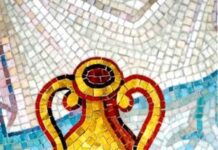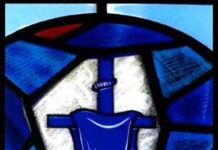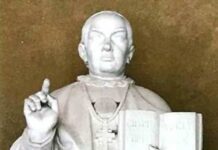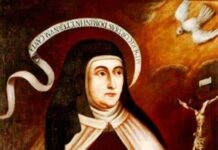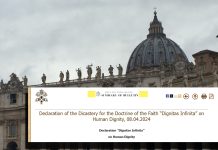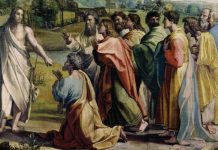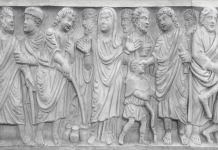
We believe that those in this world who truly believe in Christ –the Church Militant– conform His Mystical Body. “For just as the body is one and has many members, and all the members of the body, though many, are one body, so it is with Christ. For by one Spirit we were all baptized into one body—Jews or Greeks, slaves or free—and all were made to drink of one Spirit.” (1 Corinthians 12:12-13 RSVCE)
Those who study the Holy Gospel in depth often see that the life of Christ is a model of the life of His Church. That is implicit in Jesus’ prophetic message: “And when they bring you before the synagogues and the rulers and the authorities, do not be anxious how or what you are to answer or what you are to say; for the Holy Spirit will teach you in that very hour what you ought to say.” (Luke 12:111-12 RSVCE) Many of those who profess to be Christians will have to go through trials and persecution just like He did. “A disciple is not above his teacher, nor a servant above his master; it is enough for the disciple to be like his teacher, and the servant like his master. If they have called the master of the house Beelzebub, how much more will they malign those of his household.” (Matthew 10:24-25)
In the previous article A Prophetic Model For Our Days we examined the trial of Jesus and found there the actors that would struggle for or against God’s Kingdom until the final days of this world.
- The false believers for whom Jesus is not a good enough Messiah. They decide to become themselves a sort of alternate body. They are the revolutionaries, the friends of Barabbas, enemies of the established order (Rome) and opposed to the coming Kingdom of God. They are essentially against Christ and do not want Him as their King.
- The second actor is Rome, the rulers of the world represented by Caesar and Pontius Pilate. Rome, and those who control the world to this day are allowed by God to keep civil order until the times are ripe for the arrival of God’s Kingdom. The prophet Daniel announced that a series of kingdoms would exist all the way until the end of the Times of the Gentiles: “And in the days of those kings the God of heaven will set up a kingdom which shall never be destroyed, nor shall its sovereignty be left to another people. It shall break in pieces all these kingdoms and bring them to an end, and it shall stand for ever.”
- The third actor is Christ, rejected by both Rome and by the revolutionaries. After the Crucifixion, the Church will take his place entering a long period in which both the powers of this world and the revolutionaries will oppose and persecute Jesus’ followers thus purifying the Church Militant through various sufferings.
A House of Prayer for all nations: the universal destiny of Israel
In A Prophetic Model For Our Days we also considered the Visitation. (Luke 1:39-56) In that scene of the Gospel According to St. Luke the image presented to us symbolizes the end of the age of the Law and the Prophets and the beginning of the universal mission of Israel: the age of the Church. Two pregnant women meet. Their babies are scheduled to be born six months apart. One is going to be born in the spring and the other in winter. One is John the Baptist, the son of a Levite priest. John is going to be the last prophet of his age. Jesus the other baby will be the firstfruits of the age of the Church. That Church will fulfill the ancient prophecy predicting the universal destiny of Israel:
“These I will bring to my holy mountain, and make them joyful in my house of prayer; their burnt offerings and their sacrifices will be accepted on my altar; for my house shall be called a house of prayer for all the nations.” (Isaiah 56:7)
That is the sacred universal destiny that the revolutionaries present in the Praetoria rejected. When they shouted the lie “we have no king but Caesar” they inaugurated the age of revolution. Those were the first to be both in opposition to the established human order permitted by God, and also against the Kingdom that God had promised to Abraham and his descendants forever. In the words of Mary of Nazareth at the Visitation:
[God’s] mercy is on those who fear him
from generation to generation.
He has shown strength with his arm,
he has scattered the proud in the imagination of their hearts,
he has put down the mighty from their thrones,
and exalted those of low degree;
he has filled the hungry with good things,
and the rich he has sent empty away.
He has helped his servant Israel,
in remembrance of his mercy,
as he spoke to our fathers,
to Abraham and to his posterity for ever.
Here the actors of this ancient drama are also mentioned by Mary: “the proud in the imagination of their hearts” are the revolutionaries that imagine themselves as a Messiah. Implying that God had failed to give them a proper leader they went on with their plans to conquer the world by cunning and force. “The mighty on their thrones” are the powers of this world. Those are permitted to rule until the Kingdom of God comes to liberate this sad and suffering world. In the end, God will exalt those who welcomed the Messiah. All other pretenders to rule this world will accomplish nothing but their own destruction.
This world began to fade away from the moment when Jesus was conceived by the action of the Holy Spirit. Two millennia have passed since. The Kingdom of God has been growing all that time, imperceptibly, like a plant that prepares for spring under the frozen ground. Our Messiah was born in wintertime so God can “show the strength of his arm” when he scatters the enemies forever and springtime breaks upon the whole world: a glorious season of justice that will never end.
The Cycle of Fisherman: sailing to the depths of History
Obviously, God has a plan. Four thousand years ago, when Abraham was promised descendants as numerous as the stars of heaven, God knew exactly how that was going to be accomplished. In the mystery of Christ’s life many of God’s plans were manifested but the world was not paying attention, not even the disciples imagined the great adventure that was waiting for them.
After feeding some 4,000 men and their families, Jesus decides to sail to the opposite shore of Lake Gennesaret. There we find his enemies again.
And the Pharisees and Sadducees came, and to test him they asked him to show them a sign from heaven. He answered them, “When it is evening, you say, ‘It will be fair weather; for the sky is red.’ And in the morning, ‘It will be stormy today, for the sky is red and threatening.’ You know how to interpret the appearance of the sky, but you cannot interpret the signs of the times. An evil and adulterous generation seeks for a sign, but no sign shall be given to it except the sign of Jonah.” So he left them and departed. (Matthew 16:1-4)
The enemies ask for a sign and Jesus answers with a puzzling “no sign shall be given to them except the sign of Jonah.” Jonah was a non-Hebrew prophet (his name means “dove”) sent in ancient times to convert the powerful city of Nineveh. The prophet did not like that assignment and decided to go in the opposite direction. While trying to escape his mission Jonah ended up thrown into the sea where a big fish swallowed him up. The disobedient prophet arrived (via big fish) to a beach near Nineveh. You can read the complete story in the Book of Jonah.
There are many interpretations aimed at understanding that cryptic phrase of Jesus. As we continue reading Matthew 16 we find Jonah again when Jesus calls his disciple Simon Peter “son of Jonah” which is remarkable because Simon’s father was not called “Jonah” but “Yehoanan” adding one more piece to the mystery.
Again, the image is suggestive in many ways. The enemies are left ashore puzzled while Jesus and the disciples get on Peter’s boat and sail across the lake. Many contemplating this scene have seen a hidden parable. Those who did not accept the universal destiny of Israel are left behind. Peter’s boat signifies the Church that sails through History to fulfill the new mission of Israel. Jesus goes with them and they arrive to that part of the territory assigned to another of the three actors in the drama … the Gentiles!
Now when Jesus came into the district of Caesarea Philippi, he asked his disciples, “Who do men say that the Son of man is?” And they said, “Some say John the Baptist, others say Elijah, and others Jeremiah or one of the prophets.” He said to them, “But who do you say that I am?” Simon Peter replied, “You are the Christ, the Son of the living God.” And Jesus answered him, “Blessed are you, Simon Bar Jonah! For flesh and blood has not revealed this to you, but my Father who is in heaven. And I tell you, you are Peter, and on this rock will build my Church, and the gates of Hades shall not prevail against it. I will give you the keys of the Kingdom of Heaven, and whatever you bind on earth shall be bound in heaven, and whatever you loose on earth shall be loosed in heaven.” Then he strictly charged the disciples to tell no one that he was the Christ. (Matthew 16: 13-20)
What a great moment for Peter the Fisherman. Selected by the Holy Spirit to be the one to confirm the Messiah. At the same time, Jesus gives him the honor to be the foundation of the Church Militant holding the authority to bind and loose.
If crossing the lake is an allegory of the Church crossing the waters of History all the way to the end of the Times of the Gentiles, then we have to conclude that the rest of this chapter prefigurates something having to do with History as well. Surprising everyone, Jesus tells the disciples not to reveal to others that he is the Christ. He knows the kind of Christ that most people were expecting and he was not interested in meeting their expectations. The conquest of the world Jesus is beginning to accomplish is a spiritual conquest. He will not be the king of an imperfect world. He comes to defeat sin and death. The days of this world are counted and the Kingdom of God and its King are beginning to rule in the midst of their enemies. (Psalm 110:2-3)
Jesus begins to explain (in vv. 21-23) how the Messiah will suffer and be delivered to his enemies. He does not want the disciples to be shocked and surprised by the unexpected humiliation that lay ahead. But that is a tough concept for the disciples to understand. Peter cannot accept it either: “God forbid, Lord! This shall never happen to you!” The Fisherman then receives an unexpected rebuke: “Get behind me, Satan! You are a hindrance to me; for your thoughts are not of God, but of men.”
Notice the contrast with “flesh and blood has not revealed this to you, but my Father”. In a brief time, the thoughts of Peter have gone from being divinely inspired to the opposite: a hindrance to God’s will reminiscent of the actions of the devil. Was Jesus subtly revealing a deep secret there? Is this a parable Christ is constructing for us living at the other edge of History?
This whole chapter seems to prefigure the Cycle of Peter. What is that? It is a condensed prophetic figure of the Papacy from its luminous beginnings working side by side with the Master all the way to a time of darkness in the distant future when another Peter will even relinquish the title of Vicar of Christ and act in direct opposition to the will of God.
Only days after being rebuked, Peter ascends to Mount Tabor along with the Master, James, John, and Andrew. There Jesus is transfigured before them. (Matthew 17:1-11) Peter is completely shocked by the vision of Jesus, Moses, and Elijah. One more time the voice of God confirms the Messiah: “This is my Son, whom I love; with him I am well pleased. Listen to him!” A week earlier, God had revealed to Peter the same truths. Now all four disciples get to hear the confirmation. But Peter is so shocked that he can only utter: “Lord, it is good for us to be here. If you wish, I will put up three shelters—one for you, one for Moses and one for Elijah.” His mind is still focused in the shelter that this world has to offer, even when contemplating the reality of Jesus’ divinity next to the Law and the Prophets expressed in the persons of Moses and Elijah. Like Jonah, Peter has gone not to where God sent him but in the opposite direction. It would take him all his life to learn the lesson to the fullest.
Many years later, Peter the Bishop of Rome, is walking away from his diocese trying to escape martyrdom at the hands of Emperor Nero. We are told he had a vision of Christ carrying the Cross to Rome. When Peter asks Him “Lord, where are you going?” the divine answer was: “To Rome, to be crucified again.” That was enough to make Peter reverse his course rejecting the temptation of saving his life. Peter offered Christ a glorious martyrdom. Crucified upside down, the image aptly represents the Church Militant as a reflection of the heavenly Church Triumphant.
The Passion of the Church
It seems to me that a visible part of the Church has embraced the beliefs and ideas of this world. At the end of times, Peter has taken the wrong direction again. Perhaps there will be a divine intervention of some sort that will send the wayward back in the right direction. In the meanwhile we must keep focused like Blessed Mary of Nazareth and the young apostle John, who stood fearlessly by the Cross until the end.
I leave you with a reflection by Fr. Leonardo Castellani (1899-1981)
The Mystery of Iniquity is the hatred of God and the worshiping of man. The Two Beasts are the political power and man’s religious instinct turned against God and controlled by the false Christ and the false prophet. The Obstacle is, in our interpretation, the remaining in force of the Roman Order. The Great Harlot is religion deconstructed and surrendered to the temporal powers, and it is also the ethnic Rome, where this mystery of iniquity was revealed for the first time to the astonished eyes of John, the last apostolic visionary.
The worshiping of man combined with the hatred of God has always existed. “The mystery of iniquity is already at work” — writes St. Paul to the Thessalonians. The Mystery of Iniquity is the origin of the city of man contending with the City of God from the beginning; it is the root of all heresy and the fire of all persecutions; it is the quiet incestuousness of the creature settled on its specific difference; it is the continuous rebellion of the sinful intellect against its beginning and end, the echo multiplied through the ages of Satan’s “I shall not serve.” — “but the One who now holds it back will continue to do so till he is taken out of the way.”
The paramount of The Mystery of Iniquity is the hatred of God and the idolatrous worshiping of Man.
The Mystery of Iniquity tends to materialize in the body politic to crush the saints. It was the force that condemned Socrates to death, persecuted the prophets, crucified Jesus, and later multiplied the martyrs; and it will be the one who will destroy the Church when the Obstacle is removed, allowing the appearance of a man of satanic greatness, a commoner of perverse genius, perhaps a man of Jewish origins, superhuman intellect, absolute wickedness, to whom Satan will extend his power and his accumulated fury.
The Church, assisted by the Holy Spirit, impedes that manifestation and lessens it, resting on the human order that the Roman Empire organized in a body of laws and political practice; but the day will come for the end of this age, and the One who now holds it back, the Obstacle, will be removed. The Holy Spirit will perhaps abandon that social-historical body we call Christendom, sending his own to the most barren isolation, giving them “the wings of the great eagle to fly to the wilderness.” And then the existing temporal structure of the Church will be caught by the Antichrist and will fornicate with the kings of the Earth (if not all the Church, at least a noticeable part of it, as it has already happened in history) and the abomination of desolation will enter the holy place. “So when you see ‘the abomination that causes desolation’ standing where it ought not …” then it is fulfilled.
Will that be the reign of an Anti-Pope or a false Pope? Will that involve the material destruction of Rome? Would that be the ascension of a sacrilegious cult? We do not know. We know that the Apocalypse of St. John, when describing the Great Harlot points with all precision to “the city of seven hills.” That interpretation is given by the very angel who is revealing the doctrine to St. John. (Leonardo Castellani, Cristo: Vuelve O No Vuelve? Ediciones Vórtice, Buenos Aires)
Lord, have mercy.



